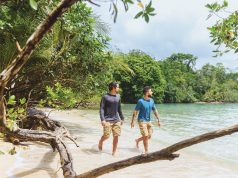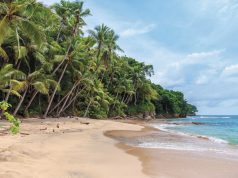Hundreds of kilometers full of activities and tropical wonders to discover
Panama has beaches on the Atlantic with crystal clear waters, white sands and dreamy sunsets. It is a coast that, although it does not have a tourist development like on the Pacific side, has a natural and paradisiacal beauty that will motivate you to return many times.
Bastimentos Beaches
Isla Bastimentos, with its more than 50 square kilometers, is one of the largest islands in Panama. Located just 10 minutes by water taxi from Isla Colon, it is a wonderful tourist destination with pristine beaches, surrounded by great biodiversity and the opportunity to learn about Afro-Caribbean culture.
The beaches, without a doubt, will be one of the places where you will most want to spend time. The first one you have to visit is Playa Polo, with calm waters and surrounded by corals, it is almost deserted so you can enjoy it a lot. The next beach is Coral Cay, ideal for diving or snorkeling, its name says it all, a beach with access to a wide variety of corals. We also recommend that you go to “Old Bank”, an Afro-Caribbean community that preserves its language, architecture and rich culture. There is a path that you can walk in the middle of the tropical forest towards “Wizard”, a huge and virgin beach, simply beautiful, you will love it just by seeing it.
To get there, you have to travel to the Bocas del Toro archipelago, more than 600 kilometers away from Panama City. Driving by road to Almirante port (by public transport or driving) and from there board the ferry or a speedboat to Isla Colon or to the place where you are going to stay. There are also internal airlines that offer direct flights to Bocas, the main city of the archipelago.
Playa Estrella
Located on Isla Colon, Bocas del Toro, it bears that name because dozens of giant starfish live there, one of the best experiences you can imagine.
Here you will see numerous starfish as long as you respect their habitat so that it remains a paradise. The sea stars have 5 arms, and reddish in color, about 20 and 40 centimeters, and believe it or not, they move at high speed thanks to a natural hydraulic system that they possess.
To get to the beach, the best option is to do it in one of the many collective minibuses that travel from the town of Bocas, on Isla Colon, to Bocas del Drago, in the northwest part of the island. The ticket is $5.00 (round trip) and it takes 30 minutes to get there. From the bus stop to Playa Estrella there is a relaxing 20-minute walk.



Calovebora Beach
A beach that recently has land access through a modern highway that connects the community of El Guabal with Calovebora. It has been commented for many years that it is one of the best beaches in the Panamanian Atlantic.
The community that lives in the surroundings of this beach is 4,397 people, mostly dedicated to fishing, agriculture and lately to tourism, having comfortable places to stay. The beach is a dream, it is wide and long, making it very attractive when you are looking for a remote but easy to reach beach.
The community maintains a sustainable development, offering from tours to the beautiful Escudo de Veraguas island, diving and kayac activities, as well as fishing in the river that flows into the sea.
Miguel de la Borda
Located in the last town where the highway from Costa Abajo de Colon reaches. It is a very quiet town with approximately 3,000 inhabitants. Mostly inhabited by people of Negroid and indigenous descent, who are dedicated to subsistence agriculture and artisanal fishing.
Here you find one of the most extensive, beautiful and quiet beaches of Costa Abajo. Nothing to envy to beaches in other sectors of the country. Among the activities that you can do apart from taking a refreshing swim in its waters, you can take boat tours along the coast, rest in a hammock and make bonfires at night.
To get there, it takes about 2 hours and 30 minutes of travel, crossing the Panama Canal through the new bridge in the Atlantic.
Huerta Beach, Puerto Frances and Playa Blanca
Right at the entrance to Portobelo, immediately after the first ruins, you will find a small pier with parking lots, from where boats will take you to three fascinating beaches. There the boat drivers offer the service of taking you back and forth at the time and day you want.
These beaches cannot be seen from the pier and are in the following order of distance: Playa Huerta, Puerto Frances and the furthest: Playa Blanca (30 minutes away).
These beaches are surrounded by tropical rain forest that is part of the Portobelo National Park. Here you find howler monkeys, squirrels, and birds of different species. There is also marine fauna such as crabs, jumping fish, among others.
In each of these beaches there is enough space to camp, but you must take everything since there is only beautiful nature (flashlights, mosquito repellents, tent, water and edible supplies). In these you can dive, swim and practice snorkeling, activities that you will fully enjoy.
The most attractive beach of the three is Playa Blanca, which has a small bay that is part of the Portobelo National Park. It is a beach perfect for camping, snorkeling and exploring the area’s forests. It has very calm, transparent waters with white coral sand, the latter is due to the fact that it is located in the middle of mangroves to the east of the Las Tres Marias islands.
Playa Damas, Nombre de Dios
Located in the farthest sectors of Costa Arriba de Colon, three and a half hours from Panama City, it is a privileged place, since Nombre de Dios has many natural beauties and historical importance. Here you will enjoy beaches and both ecotourism and marine activities.
It is a town and port founded by the Spanish explorer Diego de Nicuesa in 1510, being one of the first towns of the Spanish colony in the American continent. It became the first port on the mainland for the fleet of Indians, and an important part of the route to the Philippines, which allowed the construction of an 80-kilometer stone road from Nombre de Dios to Panama City.
Playa Damas stretches along 1.5 kilometers of salt and pepper colored sands. The first section is located in the village lined with houses. The second section to the east there is only sand and palm trees. This tropical paradise will seduce you with its warm and crystal clear waters, surrounded by nature and more nature.
On the green grass you will discover an abandoned anchor that according to the fishermen has been there since the time of the conquest. In this sector, the water level is deeper and you can watch various marine species including sea urchins, fish and stingray. A true treasure of this Caribbean province.











